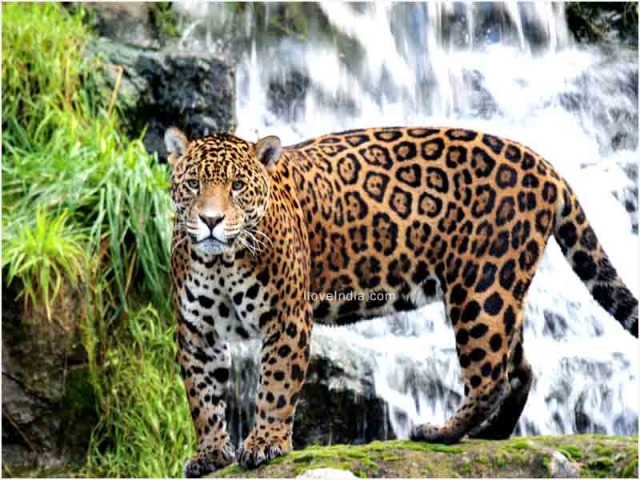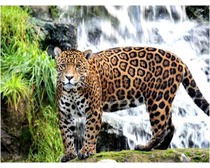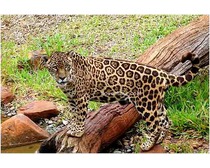Jaguars are often regarded as symbols of power and beauty. In this article, we bring you some interesting facts and amazing information on jaguars.
Facts About Jaguar
Jaguar is one of the biggest felines of the American continent and is perhaps one of the most amazing and beautiful creature that exists on the face of the earth. Known since pre-historic times, a number of legends and myths have been associated with this animal over the last few centuries. Locals of the Mayan civilization believed that Jaguar was the ‘Lord of the Underworld’ and helped the sun rise every morning and move under the earth at night. These powerful wild animals have a sleek muscular body and can be easily identified from a distance. Their razor-like teeth, sharp claws and powerful jaws makes them excellent hunters. They can even climb trees to gain more leverage to jump on their prey and attack them. However, recently, there has been a sudden decline in the number of these animals, as they are hunted for their attractive fur. To protect this amazing species, a number of wildlife protection units and animal conservation organizations are constantly striving in different corners of the world. Get a brief introduction to the unique species ‘jaguar’ through the interesting facts and amazing information given below.

Facts About Jaguar
Binomial Name: P. onca
Kingdom: Animalia
Phylum: Chordata
Subphylum: Vertebrata
Class: Mammalia
Order: Carnivora
Family: Felidae
Genus: Panthera
Species: Panthera onca
Length: Head and body length: 1120 to 1850 mm, tail length: 450 to 750 mm
Weight: Male: 90 to 120 kg, Female: 60 to 90 kg
Life Span: Approximately 24 years
Diet: Peccaries, tapirs, crocodilians, capybaras and fish
Range: Southern United States to Argentina
Habitat: Forests and savannahs occasionally scrub and desert areas, very close to a substantial fresh water source
Age of Sexual Maturity: 2 to 4 years
Gestation Period: 93 to 105 days
Number of Offspring: One to four
Interesting & Amazing Information On Jaguars
- Jaguars are the largest members of the South American cat family, with a recorded weight of over 347 pounds.
- Once abundant throughout the country, today, significant numbers of jaguars can be located only in certain regions of South and Central America, especially in the Amazon basin.
- The largest jaguars have been located in the Brazilian Pantanal region, with an average massive weight around 220 pounds or 100 kg (males).
- Though these animals are high territorial in their nature and are known to mark their boundaries, occasional shifts to areas well beyond their established territory have been made by male jaguars.
- Jaguars mark and define their territories either with their waste or by clawing trees.
- Typically, jaguars have a tan or orange shade, with distinct black spots called ‘rosettes’ all over their body. These spots are so called because they are shaped like roses. In some jaguars, these spots are not very prominent, because of the darker shade of their body.
- Generally, the litter size of jaguars is between one and four cubs. The cubs are blind and very helpless at birth and hence require protection from their mother, against any kind of predators.
- The young ones learn the skill of hunting by living with their mother for a period of around 2 years, or slightly more.
- Some of the major threats to this species of wild cat are deliberate elimination, deforestation and population fragmentation. These animals are hunted for their attractive fur. Ranchers also kill them as they sometimes prey on the livestock.
- Jaguars are enlisted under the IUCN (International Union for the Conservation of Nature) as a near-threatened species. Also, they are listed under the Appendix I of CITES (Convention on International Trade in Endangered Species), which means that any kind of international trade on Jaguars is prohibited.


See also
More from iloveindia.com
- Home Remedies | Ayurveda | Vastu | Yoga | Feng Shui | Tattoos | Fitness | Garden | Nutrition | Parenting | Bikes | Cars | Baby Care | Indian Weddings | Festivals | Party ideas | Horoscope 2015 | Pets | Finance | Figures of Speech | Hotels in India : Delhi | Hyderabad | Chennai | Mumbai | Kolkata | Bangalore | Ahmedabad | Jaipur
- Contact Us Careers Disclaimer Privacy Policy Advertise With Us Lifestyle Sitemap Copyright iloveindia.com. All Rights Reserved.




